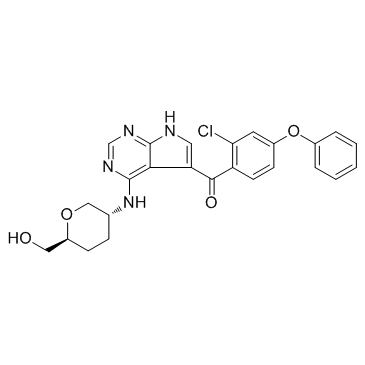2095393-15-8
| Name | JTZ51LIXN4 |
|---|---|
| Synonyms |
1,5-Anhydro-2-{[5-(2-chloro-4-phenoxybenzoyl)-7H-pyrrolo[2,3-d]pyrimidin-4-yl]amino}-2,3,4-trideoxy-D-erythro-hexitol
JTZ51LIXN4 D-erythro-Hexitol, 1,5-anhydro-2-[[5-(2-chloro-4-phenoxybenzoyl)-7H-pyrrolo[2,3-d]pyrimidin-4-yl]amino]-2,3,4-trideoxy- ARQ 531 |
| Description | ARQ 531 is a reversible non-covalent inhibitor of Bruton’s Tyrosine Kinase (BTK), with IC50s of 0.85 nM and 0.39 nM for WT-BTK and C481S-BTK, respectively. |
|---|---|
| Related Catalog | |
| Target |
IC50: 0.85 nM (WT-BTK), 0.39 nM (C481S-BTK)[1]. |
| In Vitro | ARQ 531 shows strong target inhibition in TMD8 cell line. The IC50 values are 0.85 nM and 0.39 nM for WT-BTK and C481S-BTK, respectively, in biochemical assay. Additionally, ARQ 531 also shows strong inhibition of TEK kinases with IC50s of 5.23 nM (BMX), 5.80 nM (TEC), 36.4 nM (TXK). The IC50s of ARQ 531 for SRC kinases are 3.86 nM (LCK), 4.22 nM (YES), 9.71 nM (BLK), 18.3 nM (HCK), 18.8 nM (LYNa), 25.9 nM (FGR), 32.2 nM (FYN), 48.0 nM (FRK) and for TRK kinases are 11.7 nM (TrkB), 13.1 nM (TrkA), 19.1 nM (TrkC). ARQ 531 inhibits proliferation of diverse types of cell lines (TMD8: GI50=1.7 nM, REC1: GI50=0.55 nM) and shows potency in cell lines that are addict to BCR, Src-family kinase and PI3K/AKT pathways. |
| In Vivo | ARQ 531 is efficacious in TMD-8 tumor xenograft model. ARQ 531 causes complete tumor regression after 14 days of treatment. ARQ 531 is also efficacious in collagen induced arthritis model. ARQ 531 demonstrates potent efficacy against arthritis in mouse model. In the BTK driven TMD8 xenograft mouse model, ARQ 531 demonstrates excellent anti-tumor activity with durable response. ARQ 531 demonstrates in vivo efficacy in a mouse collagen-induced arthritis (CIA) model[1]. |
| Cell Assay | Biochemical inhibition assay is measured using full length BTK constructs of wild type or C481S mutant. Profiling on 236 kinases identifies 45 kinases with >50% inhibition at 200 nM concentration of ARQ 531. Subsequently, the potency of this ATP competitive inhibitor is determined on such kinases at the physiological 1 mM ATP concentration cells are treated with increasing concentrations of inhibitors in SUDHL-4 for 2 hours, following stimulation with either anti-IgM or growth factors cells are lysed for Western blot analysis[1]. |
| Animal Admin | Mice[1] Six week old female CB-17 SCID mice (1-2 weeks) are used. Mice are housed in sterile micro isolator cages, five mice per cage and receive food and water ad libitum. Female SCID mice are implanted subcutaneously with 8x106 TMD8 cells in 0.2 mL HBSS with 50% standard concentration BD matrigel in the upper right flank area. Mice are monitored and staged on day 14 (post injection of tumor cells) when size reaches approximately 400 mg. Oral daily dosing with ARQ 531 at 100 mg/kg, vinblastine or vehicle began on stage day. Tumor measurements and body weights are collected three times a week. In vivo Target and pathway inhibition is studied in mouse TMD8 xenograft model. Percent inhibition relative to the vehicle control is determined using densitometry analysis and the intensity of actin band is used as a loading control and the percentage of vehicle group is designated as 100%. DBA1/J mice are immunized with collagen to develop the arthritis, following the onset of arthritis, mice are randomized into treatment groups. Treatment is initiated by oral dosing of ARQ 531 at 25, 50 and 75 mg/kg and continued daily through arthritis day 14. Clinical scores are assessed for each of the paws on study arthritis days 1-15. Dexamethasone at 3 mg/kg is used as a control[1]. |
| References |
| Density | 1.4±0.1 g/cm3 |
|---|---|
| Boiling Point | 731.6±60.0 °C at 760 mmHg |
| Molecular Formula | C25H23ClN4O4 |
| Molecular Weight | 478.927 |
| Flash Point | 396.2±32.9 °C |
| Exact Mass | 478.140778 |
| LogP | 3.87 |
| Vapour Pressure | 0.0±2.5 mmHg at 25°C |
| Index of Refraction | 1.687 |
| Storage condition | -20℃ |
| Hazard Codes | N |
|---|
